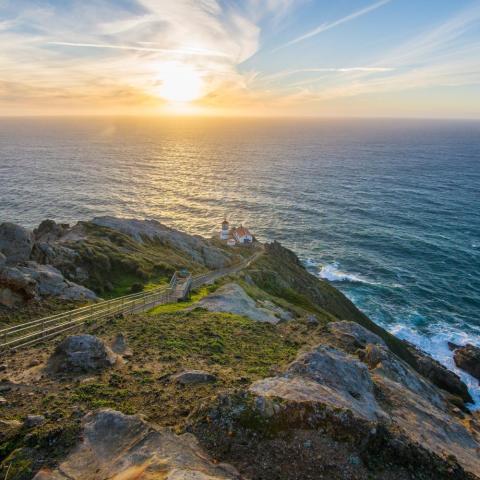
Aerial photograph of Tomales Point/NPS, Anela Kopshever
The National Park Service is seeking comment on its proposal to remove the tule elk fence and all temporary water systems on Tomales Point in Point Reyes National Seashore in California.
Under the preferred alternative for the Tomales Point Area Plan (TPAP) and environmental assessment, the Park Service would also include potential opportunities to improve recreational uses and visitor experience at the historic Pierce Ranch, approaches to preserve and maintain the wilderness character of the Phillip Burton Wilderness in the planning area, and methods to better protect natural and cultural resources.
A final decision on the Tomales Point Area Plan is expected later this summer.
The new plan will replace the 1998 Tule Elk Management Plan and revise the 1980 General Management Plan (GMP) for Tomales Point. The 2,900-acre planning area includes all lands north of and including the tule elk enclosure fence. More than 85 percent of the planning area is within the Phillip Burton Wilderness. This plan is separate from the recent GMP Amendment, which addresses all NPS lands leased for ranching and the management of elk on those lands.
The new plan will update guidance for this area with a focus on preservation of park resources, type and intensity of allowed development, guidance for visitor use and capacities, in addition to the management of tule elk at Tomales Point. The NPS is collaborating with the Federated Indians of Graton Rancheria to incorporate tribal views and traditional ecological knowledge into the management of this area.
Public and stakeholder engagement have been important to the development and refinement of this plan and the preferred alternative.
This additional 30-day public review and comment period will end on Wednesday, June 5, at 10:59 p.m. Pacific Time (PT). The NPS will host a virtual public meeting on Wednesday, May 22, at 5 p.m. Pacific Time. Meeting Registration Link: bit.ly/4d780Jl.
The preferred method for commenting is online through the NPS Planning, Environment and Public Comment website parkplanning.nps.gov/tpap.
Comments may also be submitted by mail or hand delivery to:
Tomales Point Area Plan
c/o Superintendent
Point Reyes National Seashore
1 Bear Valley Road
Point Reyes Station, CA 94956
Please note that comments will not be accepted by fax, email, USB drive, or any other way other than those specified above. Bulk comments submitted on behalf of others in any form are not accepted.




 Support Essential Coverage of Essential Places
Support Essential Coverage of Essential Places







Comments
Enough! With the tribal nonsense!
they are CITIZENS like EVERYONE else. Why the preferential treatment is beyond me.
what a political joke the nps has become.
How is collaborating with the local tribe giving them "preferential treatment"?
Giving no bid contracts to certain Americans based on their ethnicity is the heigh of preferential treatment. In fact I would go one farther- it is a violation of the fair and equal rights act.
The tribes are able to apply for a job on USAJOBS gov like EVERYONE else. Anything else is discrimination and frankly racism
Search:
1. NPS to spend millions to protect the private property of the Miccosukee Tribe in Florida
2. NPS allowed Jemez Pueblo to KILL a bald or golden eagle on Valles Caldera NM in NM.
3. Yosemite NP closes entire Tamarack Flat CG to allow local tribes the exclusive use (and trashing btw) of the campground for "ceremonies"
4. Tribal members have FREE entrance to any national park (with tribal ID) for "non-recreational" purposes (and guess how those purposes are enforced!)
...to name but 4 situations where tribes were or are afforded preferential treatment.